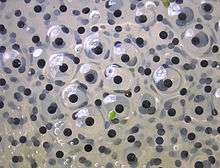External fertilization
External fertilization is a strategy of fertilization in which a sperm cell unites with an egg cell in the open, rather than inside a specialized organ within the body of a parent. Releasing eggs and sperm into water is called spawning. In contrast, internal fertilization takes place inside the female after insemination through copulation. Among vertebrates, most amphibians and fish utilise external fertilization, with eggs being liberated into the environment by the female and sperm by the male. In many cases, a clutch of eggs is laid and the male immediately liberates his sperm in close proximity.
Many invertebrates reproduce by external fertilization. In aquatic environments the sperm typically have flagella and swim to the egg. Vast numbers of gametes may be involved and some organisms such as corals, synchronise the emission of their gametes to increase the chances of successful fertilization. Plants use internal fertilisation apart from a few aquatic non-vascular plants.
External fertilization
External fertilization is where the eggs and sperm involved in sexual reproduction unite outside the body of the parent organisms. In this process, there needs to be some way of getting the sperm to the egg. Since the morphology of sperm in most species is adapted to mobility in suitably watery liquids, the sperms of aquatic animals take advantage of the water in which they live, and reach the egg by swimming. Typically such sperms have one or more flagella and in some species they are streamlined.
Hardly any plants make use of external fertilization, except for a minority of aquatic non-vascular plants such as algae; vascular plants retain the ova in the parental body till after fertilisation.
In many aquatic animals such as coral and hydra, eggs and sperm are simultaneously shed into the water, and the sperm swim through the water to fertilize the egg in a process known as broadcast fertilization.
Among vertebrates most species of fishes and amphibia reproduce by external fertilization, but the details vary widely. Some species produce floating eggs and sperm, some attach the eggs to plants or other substrates, in some, such as salmon, the female deposits unfertilized eggs in a hollow in a gravelly stream bed and the male swims by and fertilizes them. In mouth brooding species such as some cichlids, the eggs are fertilized externally in a courting "nest" then taken up in the mouth of one or both parents for protection during their development. Development in amphibians varies similarly widely, but the fertilisation is external, whereas some fishes practice internal fertilisation.
External fertilization demands relatively large numbers of sperm cells, typically millions to billions per male, because there is no high concentration of the eggs and sperms in a particularly limited space. There also is likely to be a larger number of eggs than in species that practise internal fertilization, because externally fertilized eggs and young are exposed to greater risks from predators than internally fertilized young.

